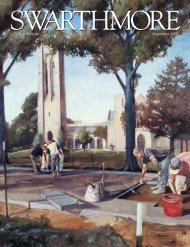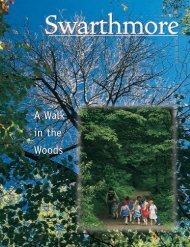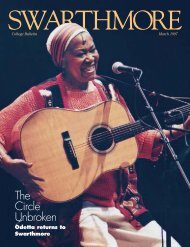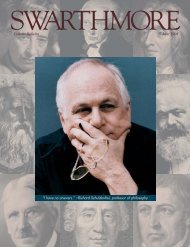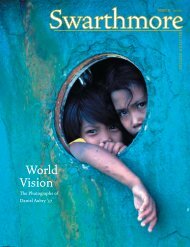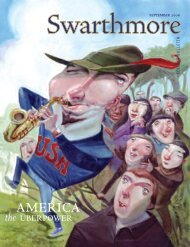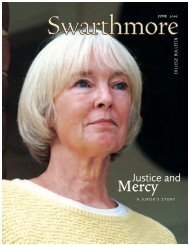TRUTH
Swarthmore College Bulletin (December 2006) - ITS
Swarthmore College Bulletin (December 2006) - ITS
- No tags were found...
You also want an ePaper? Increase the reach of your titles
YUMPU automatically turns print PDFs into web optimized ePapers that Google loves.
PHOTOGRAPHS COURTESY OF THE <strong>TRUTH</strong> IN TRANSLATION PROJ-ECTfrom conflict, including Sri Lanka, NorthernIreland, Sierra Leone, the Balkans, Israel,and Palestine, and then, to film the subsequentdialogue for a documentary. The documentaryfilm is as important to his conceptionof the Truth in Translation project as theplay itself.The translators had no choicebut to drop their masks, toacknowledge that not only iseveryone capable of good, butalso that everyone—with noexemptions, not even for theself—is capable of evil.Lessac speaks of Truth in Translation like anytheater director would, in staccato notes—words and phrases that signify wholes:“Let’s talk about hope,” he says, explainingthat, deep down, all he wanted when hereturned to his theater roots in 2001 was topresent a play about how people canchange.“Let’s talk about beneficiaries,” he says,pausing to remember that in all discussionsof victims and perpetrators, there are alsounseen millions who stand by quietly benefitingfrom systematic oppression.“Let’s talk about dark humor tonight;let’s talk about dropping the mask tonight.”Humor, says Lessac, is fundamentally abouta shift in perception, the ability to seeanother person more fully. And so Truth inTranslation is perhaps strangely but deliberatelyfunny as characters shift their gazesand drop the masks that keep them separate.To Lessac, much of the dramatic powerof the translators is that they had no choicebut to drop their masks, become somebodyelse, to acknowledge that not only is everyonecapable of good, but also that everyone—withno exemptions, not even for theself—is capable of evil.As former TRC chairman ArchbishopDesmond Tutu told Lessac—a man whoonce believed forgiveness to be no morethan a Christian ploy to keep the less powerfulsubordinate: It is exactly this “awarenessthat we’re all capable of committing theworst atrocities” from which our capacity toforgive should flow.Lessac displays an easy but enthusiasticenergy when he speaks of the project, hisstaccato notes building to reveal his ideason acting, politics, history, and the future.The TRC is a source of inspiration, he says,an example of peaceful reconciliation thatshould be shared worldwide. “I’ve begun tothink the planet will survive,” he says. “Imust say that I didn’t really think thatbefore I started this project.”As warm as he is intense, Michael Lessac isa man who has found his message to theworld and wants nothing more than to passit along. His words circle articulately aroundthe themes he sees clearly, racing in anattempt to catch up with his thoughts onthe project into which he has sunk his souland some of his savings.The Truth in Translation project “feltTruth in Translation is more than a play.The project seeks to address the consequencesof genocide and civil strifearound the world. Final rehearsals beforeits Johannesburg premiere in Septemberwere held in Rwanda, where cast memberssuch as Fana Mokoena (above left)and Nick Boraine (above right) visitedthe sites of the genocide there.right,” Lessac says, “like it was the thing inmy life I had spent a lot of time doing differentthings to reach.” The son of a voice,movement, and body instructor, ArthurLessac, who still teaches at age 97, Michaelentered Swarthmore with plans to be a scientist,switched to the social sciences, andproceeded after graduation to obtain aPh.D. in perceptual and developmental psychologyat the University of Pennsylvania.But by then, Lessac—who acted atSwarthmore and directed his very first showin Clothier Memorial Hall—knew he wanteda life lit by stage lights.He received a Ford Foundation Grant totravel around the world, working as anassistant to theater directors in Russia,Yugoslavia, Czechoslovakia, and Germany,before returning stateside to teach psychologyat Columbia University, the State Universityof New York, and the University of Minnesota.It was in Minneapolis that Lessacmet Jackie, a professional dancer, andenjoyed a stint as a singer/songwriter afterbeing discovered in the Guthrie Theater byBob Dylan’s brother, David Zimmerman,and signing with Columbia Records for the1968 album Sleep Faster, We Need the Pillow.But it was in directing—not acting,music, or psychology—that Lessac most felthe could make an impact. In 1974, he18 : swarthmore college bulletin



